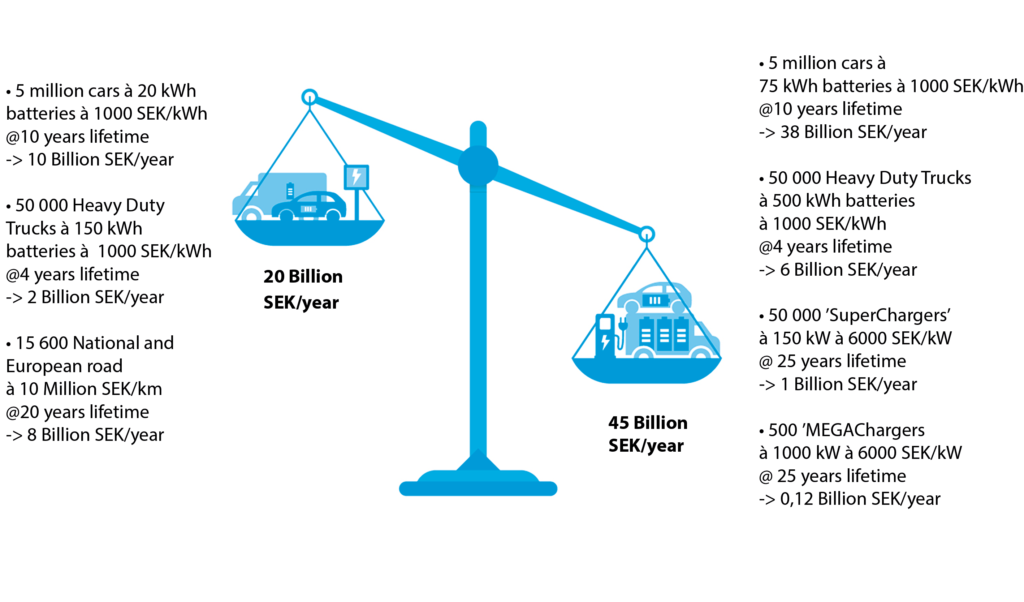What is the cost of electric roads?
Without electric roads we need a large number of fast chargers, and vehicles with a high battery capacity for extended range driving. With electric roads we can have much lower battery capacity in our vehicles and much fewer fast charging stations. So the question is, what is the most efficient option for the society as a whole?
Electric roads allows smaller batteries in our vehicles. If we instead rely on using charging stations, our vehicles need larger batteries. Comparing the cost of an charging infrastructure of electric roads + smaller batteries with the cost of a fully deployed network of super charging stations + larger batteries, the cost of the electric road is roughly estimated to be less than half the cost of the alternative.
An example
If we only build our charging infrastructure on fast charging stations, it is likely that each passenger car in the future needs 50-100 kWh of battery capacity on board. As an example, let’s say it’s 75KWh. With a charging infrastructure based on electric roads, 20 kWh in battery capacity is enough. We can assume that these batteries have a 10-year lifespan.
The corresponding figures for trucks are about 500 kWh (fast charging stations) and 150 kWh (electric roads). With trucks, we expect a much shorter battery life – an assumption would be four year’s time.
We can assume that electric vehicle batteries cost about SEK 1000 per kWh. They are more expensive today, but the estimate should be seen as a prediction of what the batteries cost in the middle of the 2020s.
Fast charging stations cost about SEK 6,000 per kilowatt of charging capacity. This means that a 120 kW fast charging station (a so-called SuperCharger costs about SEK 720,000. A fast charging station for trucks, a MegaCharger, needs a charging capacity of 1000 kW and consequently costs about SEK 6 million. Fast charging stations can be assumed to have a 25-year lifespan.
Sweden has about 5 million passenger cars and about 50,000 heavy trucks. Sweden also has approximately 15 600 km of national and European roads. The electric road technologies available today cost about SEK 10 million per kilometer to build. It refers to one driving lane in each direction, which is sufficient on most roads. Electric roads can be assumed to have a 20-year lifespan.
In order to avoid long lines for fast charging, we expect to need one (1) super charger per 100 vehicles, that is 50,000 super chargers for cars and 500 mega chargers for trucks.
Put all these facts together and it can be illustrated as in the image below. The left side of the image refers to a society with a well-developed electric road infrastructure and a corresponding low need for batteries. The right side corresponds to a society without electric roads but instead with a large number of super and mega chargers and vehicles with large batteries.

We must remember that all assumptions about costs, life expectancy and more that are made above are rough expectations. Maintenance costs for electric roads and charging stations are not included. The lifespan of batteries in trucks is deliberately set short.
Conclusions
Although our assumptions are rough, we can allow ourselves to draw conclusions about the following:
- It is the vehicles’ batteries that accounts for the highest costs, by far, in a world without electric roads.
- In particular, it is the batteries of the passenger cars that comes with a major cost. Therefore, it is very important that the electric roads technology that is developed can be used by passenger cars.
- Super charging stations represent the lowest costs, in this context they are negligible.
- The total cost of depreciation per year in a Sweden of electric roads is less than half of that of a Sweden without electric roads.
In addition, electric roads reduce the need for the materials included in modern batteries, a fact that is environmentally beneficial. The electrical vehicles also weigh less and draw less energy, which is also good for the environment. Another advantage is that they become less expensive and for that reason more people are able to buy them.
In conclusion, there are many benefits to a transport system charged by electric roads.
